Application of Nanofluids in Improving the Performance of Double-Pipe Heat Exchangers—A Critical Review
Abstract
:1. Introduction
2. Heat Exchanger Performance
3. Impact of Morphology and Concentration of Nanoparticles on Nanofluid Properties
3.1. Nanofluids in Heat Exchangers
| Nanoparticles | Size (nm) | Base Fluid | Concentration (%) | Temperature Range (°C) | Observation | Ref. |
|---|---|---|---|---|---|---|
| Al2O3 | 45 | 60% ethylene glycol 40% water | 4.00 | 11.85–151.85 | Average heat transfer enhancements of 40%, 29%, and 43%, respectively. Increased pressure drop by 84%, 47%, and 100%, respectively. | [39] |
| SiO2 | 50 | |||||
| CuO | 29 | |||||
| TiO2 | 8–18 | Water | 0.25 | 30–60 | Heat transfer coefficient enhanced by up to 32%, 21%, and 16%, respectively. | [40] |
| ZnO | 12–28 | |||||
| Ag | 7–24 | |||||
| Multiwalled carbon nanotubes (MWCNT) | 20–30 | Solar glycol | 0–0.60 | 30–50 | Heat transfer enhanced by 115% for 0.04 kg/s and 0.6% concentration. A 1.56-fold increase in pressure drop for 0.08 kg/s and 0.6% concentration. | [41] |
| Fe3O4 | 50–100 | Water | 0–0.40 | 31–90 | Heat transfer enhanced by 80–90% for 0.4% concentration. Increase in pressure drop, along with the Reynolds number and the nanofluid volume concentration. | [21] |
| MgO | 45–50 | 50% water—50% ethylene glycol | 0–0.300 | 20–100 | Heat transfer enhanced by 39% at wt.% = 0.3 and friction factor increased by 33.80%. | [42] |
| TiO2 | 21 | Water | 0.2 | 15–50 | Heat transfer coefficient enhanced by 6–11%. Low penalty of pressure drop. | [43] |
3.2. Influences of Nanoparticles on Nanofluid Properties
3.2.1. Influences of Volume Concentration of Nanoparticles on Nanofluids Properties
3.2.2. Influences of Nanoparticle Size on Nanofluid Properties
3.2.3. Influences of Nanoparticle Shape on Nanofluid Properties
4. Effects of Nanofluid Characteristics on Heat Transfer Rate and Pressure Drop
4.1. Data Analysis
4.2. Effects of Nanofluid Thermal Conductivity on Heat Transfer Rate and Pressure Drop
4.3. Effects of Viscosity of Nanofluids on Heat Transfer Rate and Pressure Drop
4.4. Effects of Nanofluid Density on Heat Transfer Rate and Pressure Drop
4.5. Effects of Nanofluid Heat Capacity on Heat Transfer Rate and Pressure Drop
4.6. Effects of Nanoparticle Concentration on Heat Transfer Rate and Pressure Drop
4.7. Effects of Nanofluid Flow Regime on Heat Transfer Coefficient and Pressure Drop
5. Conclusions
Author Contributions
Funding
Conflicts of Interest
References
- Rao, V.N.; Sankar, B.R. Heat transfer and friction factor investigations of CuO nanofluid flow in a double pipe U-bend heat exchanger. Mater. Today Proc. 2019, 18, 207–218. [Google Scholar] [CrossRef]
- Omidi, M.; Farhadi, M.; Jafari, M. A comprehensive review on double pipe heat exchangers. Appl. Therm. Eng. 2017, 110, 1075–1090. [Google Scholar] [CrossRef]
- Li, H.; Wang, Y.; Han, Y.; Li, W.; Yang, L.; Guo, J.; Liu, Y.; Zhang, J.; Zhang, M.; Jiang, F. A comprehensive review of heat transfer enhancement and flow characteristics in the concentric pipe heat exchanger. Powder Technol. 2021, 397, 117037. [Google Scholar] [CrossRef]
- Cengel, Y. Heat and Mass Transfer. A Practical Approach, 3rd ed.; McGraw-Hill/Interamericana Editores, S.A.: Mexico City, Mexico, 2013; pp. 1689–1699. [Google Scholar]
- Bergman, T.L.; Lavine, A.S.; Incropera, F.P. Fundamentals of Heat and Mass Transfer, 7th ed.; John Wiley & Sons: Hoboken, NJ, USA, 2011; Available online: https://books.google.cl/books?id=5cgbAAAAQBAJ (accessed on 20 August 2022).
- Alshukri, M.J.; Hussein, A.K.; Eidan, A.A.; Alsabery, A.I. A review on applications and techniques of improving the performance of heat pipe-solar collector systems. Sol. Energy 2022, 236, 417–433. [Google Scholar] [CrossRef]
- Kavitha, R.; Algani, Y.M.A.; Kulkarni, K.; Gupta, M. Heat transfer enhancement in a double pipe heat exchanger with copper oxide nanofluid: An experimental study. Mater. Today Proc. 2021, 56, 3446–3449. [Google Scholar] [CrossRef]
- Jassim, E.I.; Ahmed, F. Assessment of nanofluid on the performance and energy-environment interaction of Plate-Type-Heat exchanger. Therm. Sci. Eng. Prog. 2021, 25, 100988. [Google Scholar] [CrossRef]
- Ding, Z.; Qi, C.; Luo, T.; Wang, Y.; Tu, J.; Wang, C. Numerical simulation of nanofluids forced convection in a corrugated double-pipe heat exchanger. Can. J. Chem. Eng. 2021, 100, 1954–1964. [Google Scholar] [CrossRef]
- Akbar, H.M.; Mohammed, A.S.; Ezzat, S.B. Hybrid nanofluid to improve heat transfer and pressure drop through horizontal tube. Mater. Today Proc. 2021, 42, 1885–1888. [Google Scholar] [CrossRef]
- Jassim, E.I.; Ahmed, F. Experimental assessment of Al2O3 and Cu nanofluids on the performance and heat leak of double pipe heat exchanger. Heat Mass Transf. 2020, 56, 1845–1858. [Google Scholar] [CrossRef]
- Mansoury, D.; Doshmanziari, F.I.; Kiani, A.; Chamkha, A.J.; Sharifpur, M. Heat Transfer and Flow Characteristics of Al2O3/Water Nanofluid in Various Heat Exchangers: Experiments on Counter Flow. Heat Transf. Eng. 2019, 41, 220–234. [Google Scholar] [CrossRef]
- Vincely, D.A.; Natarajan, E. Experimental investigation of the solar FPC performance using graphene oxide nanofluid under forced circulation. Energy Convers. Manag. 2016, 117, 1–11. [Google Scholar] [CrossRef]
- Henein, S.M.; Abdel-Rehim, A.A. The performance response of a heat pipe evacuated tube solar collector using MgO/MWCNT hybrid nanofluid as a working fluid. Case Stud. Therm. Eng. 2022, 33, 101957. [Google Scholar] [CrossRef]
- Rajesh Babu, C.; Kumar, P.; Roy, S.; Ganesan, R. A comprehensive review on compound heat transfer enhancement using passive techniques in a heat exchanger. Mater. Today Proc. 2021, 54, 428–436. [Google Scholar] [CrossRef]
- Heyhat, M.M.; Abdi, A.; Jafarzad, A. Performance evaluation and exergy analysis of a double pipe heat exchanger under air bubble injection. Appl. Therm. Eng. 2018, 143, 582–593. [Google Scholar] [CrossRef]
- Hosseinian, A.; Isfahani, A.H.M. Experimental study of heat transfer enhancement due to the surface vibrations in a flexible double pipe heat exchanger. Heat Mass Transf. 2017, 54, 1113–1120. [Google Scholar] [CrossRef]
- Bezaatpour, M.; Goharkhah, M. Convective heat transfer enhancement in a double pipe mini heat exchanger by magnetic field induced swirling flow. Appl. Therm. Eng. 2020, 167, 114801. [Google Scholar] [CrossRef]
- Setareh, M.; Saffar-Avval, M.; Abdullah, A. Experimental and numerical study on heat transfer enhancement using ultrasonic vibration in a double-pipe heat exchanger. Appl. Therm. Eng. 2019, 159, 113867. [Google Scholar] [CrossRef]
- Akbarzadeh, M.; Rashidi, S.; Keshmiri, A.; Shokri, N. The optimum position of porous insert for a double-pipe heat exchanger based on entropy generation and thermal analysis. J. Therm. Anal. 2020, 139, 411–426. [Google Scholar] [CrossRef]
- Baba, M.S.; Raju, A.S.R.; Rao, M.B. Heat transfer enhancement and pressure drop of Fe3O4 -water nanofluid in a double tube counter flow heat exchanger with internal longitudinal fins. Case Stud. Therm. Eng. 2018, 12, 600–607. [Google Scholar] [CrossRef]
- Akpinar, E.K. Evaluation of heat transfer and exergy loss in a concentric double pipe exchanger equipped with helical wires. Energy Convers. Manag. 2006, 47, 3473–3486. [Google Scholar] [CrossRef]
- Naphon, P. Heat transfer and pressure drop in the horizontal double pipes with and without twisted tape insert. Int. Commun. Heat Mass Transf. 2006, 33, 166–175. [Google Scholar] [CrossRef]
- Shirvan, K.M.; Ellahi, R.; Mirzakhanlari, S.; Mamourian, M. Enhancement of heat transfer and heat exchanger effectiveness in a double pipe heat exchanger filled with porous media: Numerical simulation and sensitivity analysis of turbulent fluid flow. Appl. Therm. Eng. 2016, 109, 761–774. [Google Scholar] [CrossRef]
- Arya, H.; Sarafraz, M.M.; Pourmehran, O.; Arjomandi, M. Heat transfer and pressure drop characteristics of MgO nanofluid in a double pipe heat exchanger. Heat Mass Transf. 2019, 55, 1769–1781. [Google Scholar] [CrossRef]
- Okonkwo, E.C.; Wole-Osho, I.; Almanassra, I.W.; Abdullatif, Y.M.; Al-Ansari, T. An updated review of nanofluids in various heat transfer devices. J. Therm. Anal. 2021, 145, 2817–2872. [Google Scholar] [CrossRef]
- Ambreen, T.; Kim, M.-H. Heat transfer and pressure drop correlations of nanofluids: A state of art review. Renew. Sustain. Energy Rev. 2018, 91, 564–583. [Google Scholar] [CrossRef]
- Gupta, M.; Singh, V.; Kumar, R.; Said, Z. A review on thermophysical properties of nanofluids and heat transfer applications. Renew. Sustain. Energy Rev. 2017, 74, 638–670. [Google Scholar] [CrossRef]
- Ganguly, R.; Singh, A.K.; Kumar, R.; Gupta, A.; Pandey, A.K.; Pandey, A.K. Nanoparticles as Modulators of OxidativStress. In Nanotechnology in Modern Animal Biotechnology. Concepts and Applications; Pawan, K.M., Sanjay, S., Eds.; Elsevier: Amsterdam, The Netherlands, 2019; pp. 29–35. [Google Scholar] [CrossRef]
- He, Q.; Zeng, S.; Wang, S. Experimental investigation on the efficiency of flat-plate solar collectors with nanofluids. Appl. Therm. Eng. 2015, 88, 165–171. [Google Scholar] [CrossRef]
- Elsheikh, A.; Sharshir, S.; Mostafa, M.E.; Essa, F.; Ali, M.K.A. Applications of nanofluids in solar energy: A review of recent advances. Renew. Sustain. Energy Rev. 2018, 82, 3483–3502. [Google Scholar] [CrossRef]
- Leong, K.; Saidur, R.; Kazi, S.; Mamun, A. Performance investigation of an automotive car radiator operated with nanofluid-based coolants (nanofluid as a coolant in a radiator). Appl. Therm. Eng. 2010, 30, 2685–2692. [Google Scholar] [CrossRef]
- Elsaid, A.M. Experimental study on the heat transfer performance and friction factor characteristics of Co3O4 and Al2O3 based H2O/(CH2OH)2 nanofluids in a vehicle engine radiator. Int. Commun. Heat Mass Transf. 2019, 108, 104263. [Google Scholar] [CrossRef]
- Navarrete, N.; Mondragón, R.; Wen, D.; Navarro, M.E.; Ding, Y.; Juliá, J.E. Thermal energy storage of molten salt –based nanofluid containing nano-encapsulated metal alloy phase change materials. Energy 2019, 167, 912–920. [Google Scholar] [CrossRef] [Green Version]
- Ding, M.; Liu, C.; Rao, Z. Experimental investigation on heat transfer characteristic of TiO2-H2O nanofluid in microchannel for thermal energy storage. Appl. Therm. Eng. 2019, 160, 114024. [Google Scholar] [CrossRef]
- Rahman, S.; Issa, S.; Said, Z.; Assad, M.E.H.; Zadeh, R.; Barani, Y. Performance enhancement of a solar powered air conditioning system using passive techniques and SWCNT /R-407c nano refrigerant. Case Stud. Therm. Eng. 2019, 16, 100565. [Google Scholar] [CrossRef]
- Adelekan, D.; Ohunakin, O.; Gill, J.; Atiba, O.; Okokpujie, I.; Atayero, A. Experimental Investigation of a Vapour Compression Refrigeration System with 15nm TiO2-R600a Nano-Refrigerant as the Working Fluid. Procedia Manuf. 2019, 35, 1222–1227. [Google Scholar] [CrossRef]
- Porgar, S.; Vafajoo, L.; Nikkam, N.; Vakili-Nezhaad, G. A comprehensive investigation in determination of nanofluids thermophysical properties. J. Indian Chem. Soc. 2021, 98, 100037. [Google Scholar] [CrossRef]
- Vajjha, R.S.; Das, D.K.; Kulkarni, D.P. Development of new correlations for convective heat transfer and friction factor in turbulent regime for nanofluids. Int. J. Heat Mass Transf. 2010, 53, 4607–4618. [Google Scholar] [CrossRef]
- Hozien, O.; El-Maghlany, W.M.; Sorour, M.M.; Mohamed, Y.S. Experimental study on thermophysical properties of TiO, ZnO and Ag water base nanofluids. J. Mol. Liq. 2021, 334, 116128. [Google Scholar] [CrossRef]
- Poongavanam, G.K.; Panchabikesan, K.; Murugesan, R.; Duraisamy, S.; Ramalingam, V. Experimental investigation on heat transfer and pressure drop of MWCNT-Solar glycol based nanofluids in shot peened double pipe heat exchanger. Powder Technol. 2019, 345, 815–824. [Google Scholar] [CrossRef]
- Arya, H.; Sarafraz, M.; Pourmehran, O.; Arjomandi, M. Performance index improvement of a double-pipe cooler with MgO/water-ethylene glycol (50:50) nano-suspension. Propuls. Power Res. 2020, 9, 75–86. [Google Scholar] [CrossRef]
- Duangthongsuk, W.; Wongwises, S. Heat transfer enhancement and pressure drop characteristics of TiO2–water nanofluid in a double-tube counter flow heat exchanger. Int. J. Heat Mass Transf. 2009, 52, 2059–2067. [Google Scholar] [CrossRef]
- Pordanjani, A.H.; Aghakhani, S.; Afrand, M.; Mahmoudi, B.; Mahian, O.; Wongwises, S. An updated review on application of nanofluids in heat exchangers for saving energy. Energy Convers. Manag. 2019, 198, 111886. [Google Scholar] [CrossRef]
- Darzi, A.R.; Farhadi, M.; Sedighi, K. Heat transfer and flow characteristics of Al2O3–water nanofluid in a double tube heat exchanger. Int. Commun. Heat Mass Transf. 2013, 47, 105–112. [Google Scholar] [CrossRef]
- Osman, S.; Sharifpur, M.; Meyer, J.P. Experimental investigation of convection heat transfer in the transition flow regime of aluminium oxide-water nanofluids in a rectangular channel. Int. J. Heat Mass Transf. 2019, 133, 895–902. [Google Scholar] [CrossRef] [Green Version]
- Asokan, N.; Gunnasegaran, P.; Wanatasanappan, V.V. Experimental investigation on the thermal performance of compact heat exchanger and the rheological properties of low concentration mono and hybrid nanofluids containing Al2O3 and CuO nanoparticles. Therm. Sci. Eng. Prog. 2020, 20, 100727. [Google Scholar] [CrossRef]
- Ciornei, F.C.; Alaci, S.; Amarandei, D.; Irimescu, L.; Romanu, I.C.; Acsinte, L.I. Method and Device for Measurement of Dynamic Viscosity. In IOP Conference Series: Materials Science and Engineering, Proceedings of the13th International Conference on Tribology, ROTRIB’16, Galati, Romania, 22–24 September 2016; IOP Publishing: Bristol, UK, 2017; Volume 174, p. 2017012041. [Google Scholar] [CrossRef]
- Saleh, B.; Sundar, L.S. Thermal performance, embodied energy and environmental CO2 emissions analyses for double pipe U-bend heat exchanger working with MWCNT/water nanofluid. Int. J. Therm. Sci. 2021, 169, 107094. [Google Scholar] [CrossRef]
- Bakthavatchalam, B.; Habib, K.; Saidur, R.; Saha, B.B.; Irshad, K. Comprehensive study on nanofluid and ionanofluid for heat transfer enhancement: A review on current and future perspective. J. Mol. Liq. 2020, 305, 112787. [Google Scholar] [CrossRef]
- Akhtar, A.Z.; Rahman, M.; Kadirgama, K.; Saidur, R.; Safiei, W. Effects of temperature and concentration on thermophysical properties of TiO2-MWCNTs-doped graphene nanofluids. Mater. Today Proc. 2021, 48, 920–925. [Google Scholar] [CrossRef]
- Shajan, S.; Baiju, V.; Krishnakumar, T.; Andrew, G.; Thomas, L.; Alex, M.; Bin Safeer, M. Experimental investigation on thermophysical properties of Therminol® 55 based hybrid nanofluids with alumina and graphene nanoplatelets for medium temperature applications. Therm. Sci. Eng. Prog. 2021, 26, 101116. [Google Scholar] [CrossRef]
- Kim, H.; Kim, J.; Cho, H. Experimental study on performance improvement of U-tube solar collector depending on nanoparticle size and concentration of Al2O3 nanofluid. Energy 2017, 118, 1304–1312. [Google Scholar] [CrossRef]
- Zhang, L.; Zhang, A.; Jing, Y.; Qu, P.; Wu, Z. Effect of Particle Size on the Heat Transfer Performance of SiO2–Water Nanofluids. J. Phys. Chem. C 2021, 125, 13590–13600. [Google Scholar] [CrossRef]
- Main, K.L.; Eberl, B.K.; McDaniel, D.; Tikadar, A.; Paul, T.C.; Khan, J.A. Nanoparticles size effect on thermophysical properties of ionic liquids based nanofluids. J. Mol. Liq. 2021, 343, 117609. [Google Scholar] [CrossRef]
- Hu, X.; Yin, D.; Chen, X.; Xiang, G. Experimental investigation and mechanism analysis: Effect of nanoparticle size on viscosity of nanofluids. J. Mol. Liq. 2020, 314, 113604. [Google Scholar] [CrossRef]
- Zahmatkesh, I.; Sheremet, M.; Yang, L.; Heris, S.Z.; Sharifpur, M.; Meyer, J.P.; Ghalambaz, M.; Wongwises, S.; Jing, D.; Mahian, O. Effect of nanoparticle shape on the performance of thermal systems utilizing nanofluids: A critical review. J. Mol. Liq. 2021, 321, 114430. [Google Scholar] [CrossRef]
- Cui, W.; Cao, Z.; Li, X.; Lu, L.; Ma, T.; Wang, Q. Experimental investigation and artificial intelligent estimation of thermal conductivity of nanofluids with different nanoparticles shapes. Powder Technol. 2022, 398, 117078. [Google Scholar] [CrossRef]
- Elias, M.; Miqdad, M.; Mahbubul, I.; Saidur, R.; Kamalisarvestani, M.; Sohel, M.; Hepbasli, A.; Rahim, N.; Amalina, M. Effect of nanoparticle shape on the heat transfer and thermodynamic performance of a shell and tube heat exchanger. Int. Commun. Heat Mass Transf. 2013, 44, 93–99. [Google Scholar] [CrossRef]
- Shahsavar, A.; Rahimi, Z.; Salehipour, H. Nanoparticle shape effects on thermal-hydraulic performance of boehmite alumina nanofluid in a horizontal double-pipe minichannel heat exchanger. Heat Mass Transf. 2019, 55, 1741–1751. [Google Scholar] [CrossRef]
- Saranya, S.; Al-Mdallal, Q.M. Corrigendum to “Computational study on nanoparticle shape effects of Al2O3-silicon oil nanofluid flow over a radially stretching rotating disk” [Case Stud. Therm. Eng. 25 (2021) 100943]. Case Stud. Therm. Eng. 2021, 28, 101534. [Google Scholar] [CrossRef]
- Dehaj, M.S.; Hajabdollahi, H. Numerical study on performance enhancement of the fin and tube heat exchanger using different nanoparticle shapes. Int. J. Environ. Sci. Technol. 2022, 19, 1407–1422. [Google Scholar] [CrossRef]
- Hajabdollahi, H.; Hajabdollahi, Z. Numerical study on impact behavior of nanoparticle shapes on the performance improvement of shell and tube heat exchanger. Chem. Eng. Res. Des. 2017, 125, 449–460. [Google Scholar] [CrossRef]
- Serour, N.M.; El-Shazly, A.H.; El-Gayar, D.A.; Nosier, S.A. Heat-transfer and hydrodynamic performance investigation of graphene-titanium dioxide composite nanofluid in micro-heat exchangers. Can. J. Chem. Eng. 2021, 99, S308–S322. [Google Scholar] [CrossRef]
- Dalkılıç, A.S.; Mercan, H.; Özçelik, G.; Wongwises, S. Optimization of the finned double-pipe heat exchanger using nanofluids as working fluids. J. Therm. Anal. 2021, 143, 859–878. [Google Scholar] [CrossRef]
- Subramanian, R.; Kumar, A.S.; Vinayagar, K.; Muthusamy, C. Experimental analyses on heat transfer performance of TiO2–water nanofluid in double-pipe counter-flow heat exchanger for various flow regimes. J. Therm. Anal. 2020, 140, 603–612. [Google Scholar] [CrossRef]
- Bahmani, M.H.; Sheikhzadeh, G.; Zarringhalam, M.; Akbari, O.A.; Alrashed, A.A.; Shabani, G.A.S.; Goodarzi, M. Investigation of turbulent heat transfer and nanofluid flow in a double pipe heat exchanger. Adv. Powder Technol. 2018, 29, 273–282. [Google Scholar] [CrossRef]
- Bahmani, M.H.; Akbari, O.A.; Zarringhalam, M.; Shabani, G.A.S.; Goodarzi, M. Forced convection in a double tube heat exchanger using nanofluids with constant and variable thermophysical properties. Int. J. Numer. Methods Heat Fluid Flow 2019, 30, 3247–3265. [Google Scholar] [CrossRef]
- Zheng, D.; Wang, J.; Pang, Y.; Chen, Z.; Sunden, B. Heat transfer performance and friction factor of various nanofluids in a double-tube counter flow heat exchanger. Therm. Sci. 2020, 24, 3601–3612. [Google Scholar] [CrossRef]
- Zheng, D.; Wang, J.; Chen, Z.; Baleta, J.; Sundén, B. Performance analysis of a plate heat exchanger using various nanofluids. Int. J. Heat Mass Transf. 2020, 158, 119993. [Google Scholar] [CrossRef]

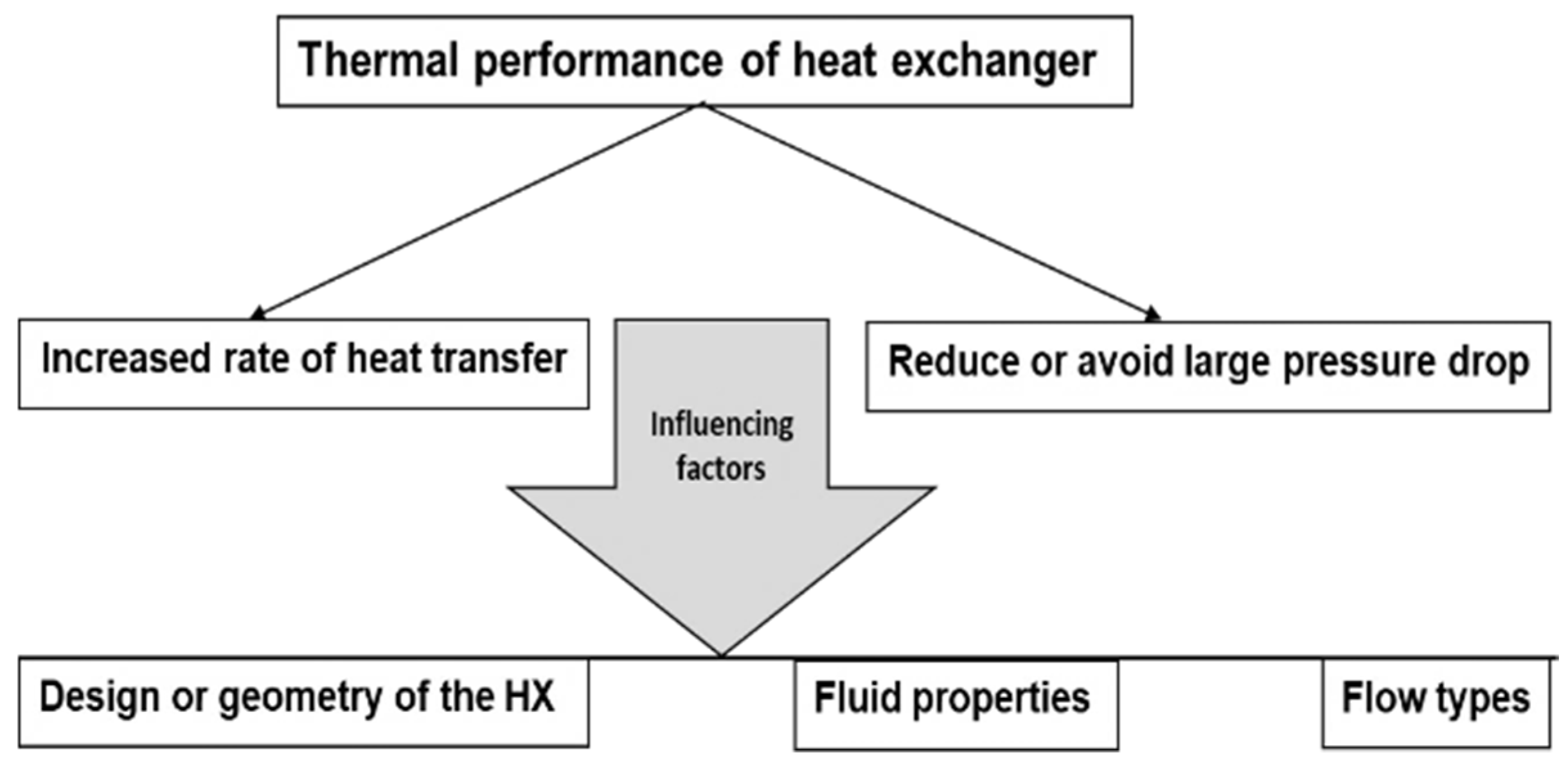





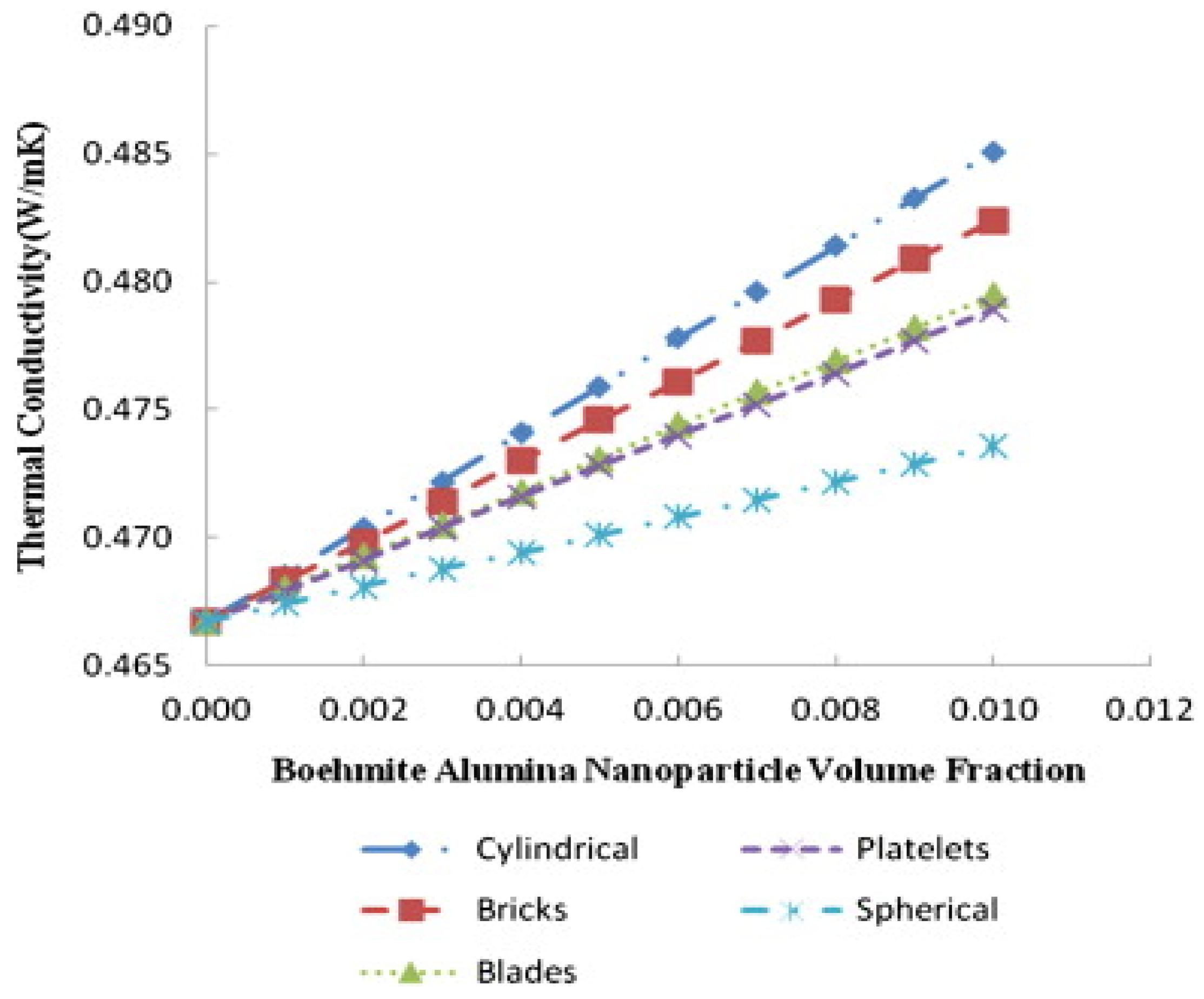
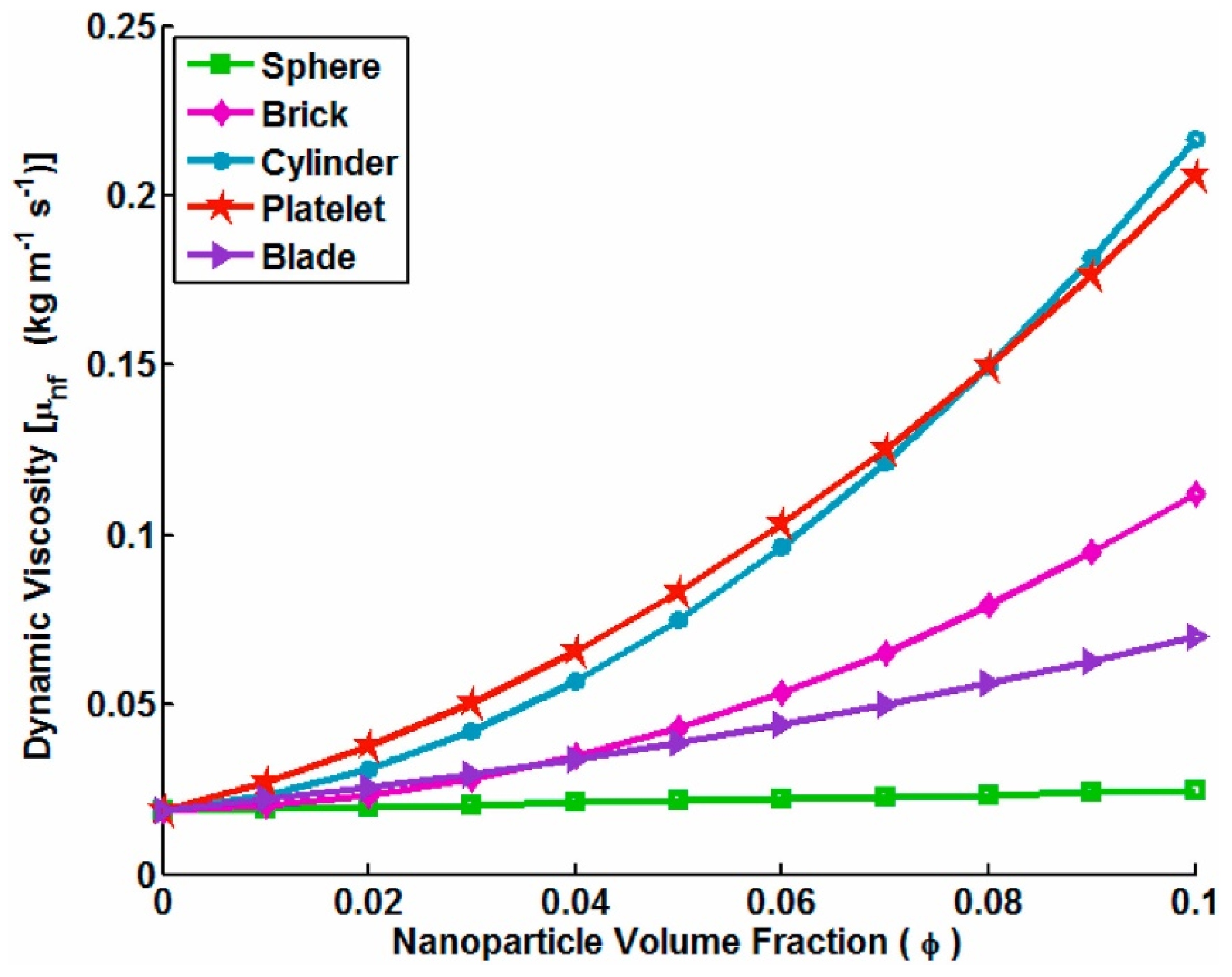
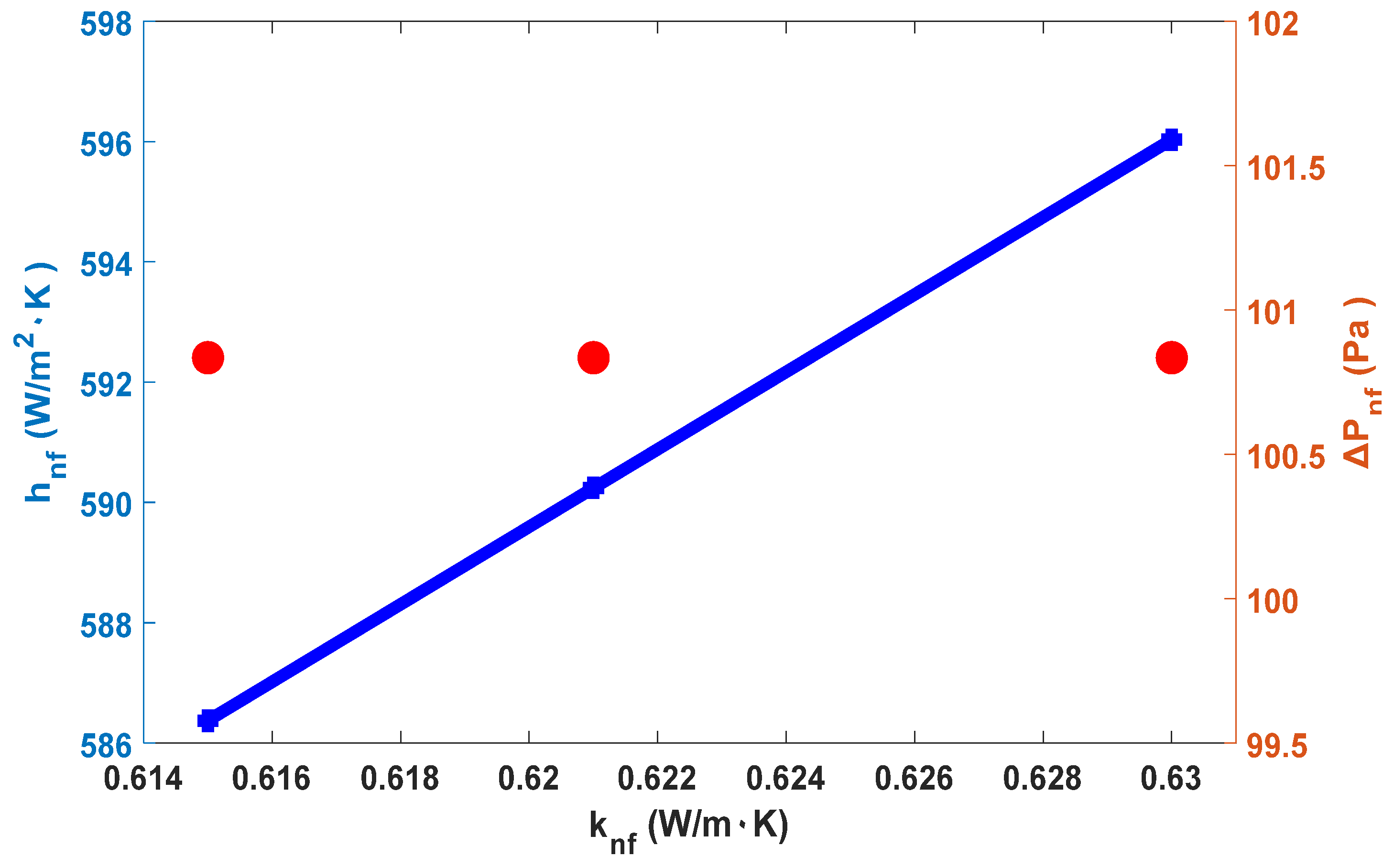
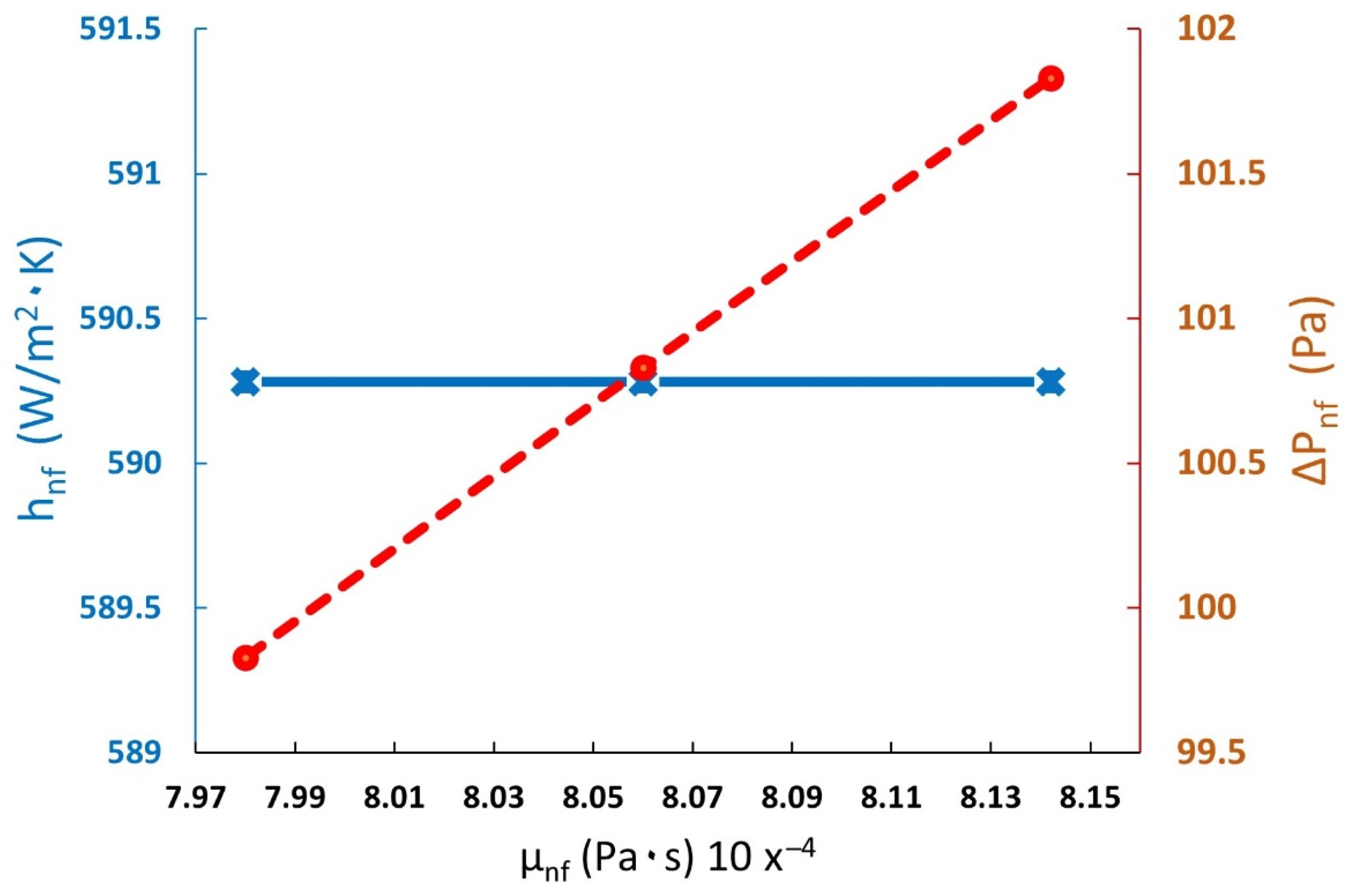
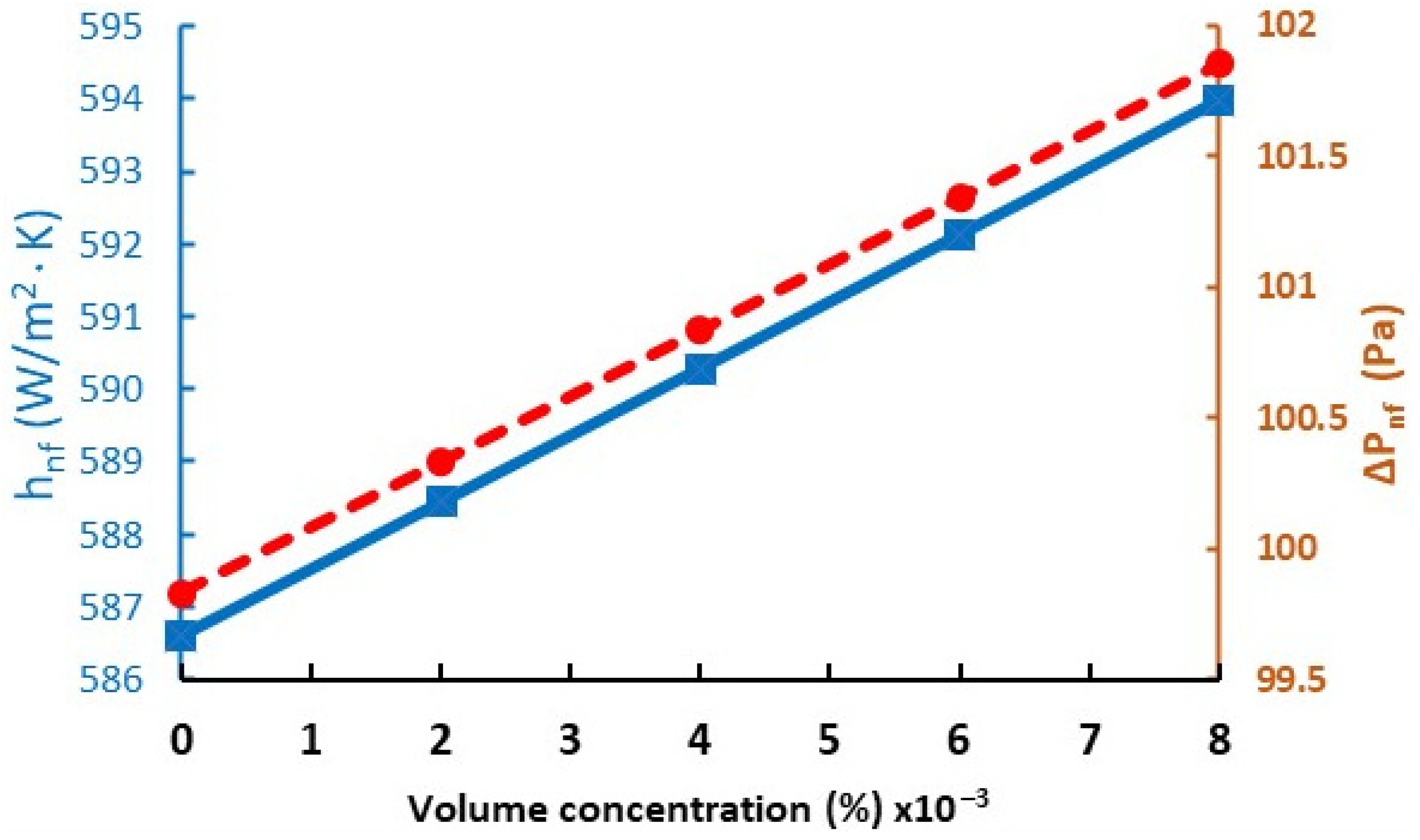
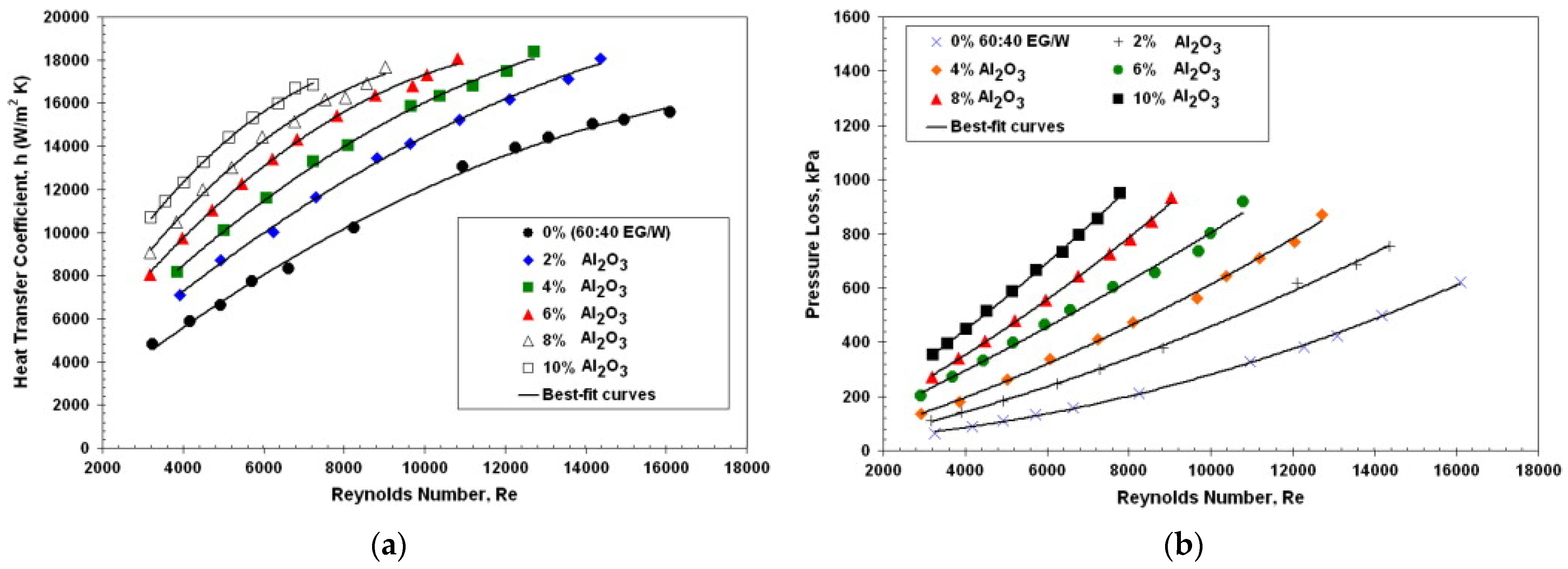
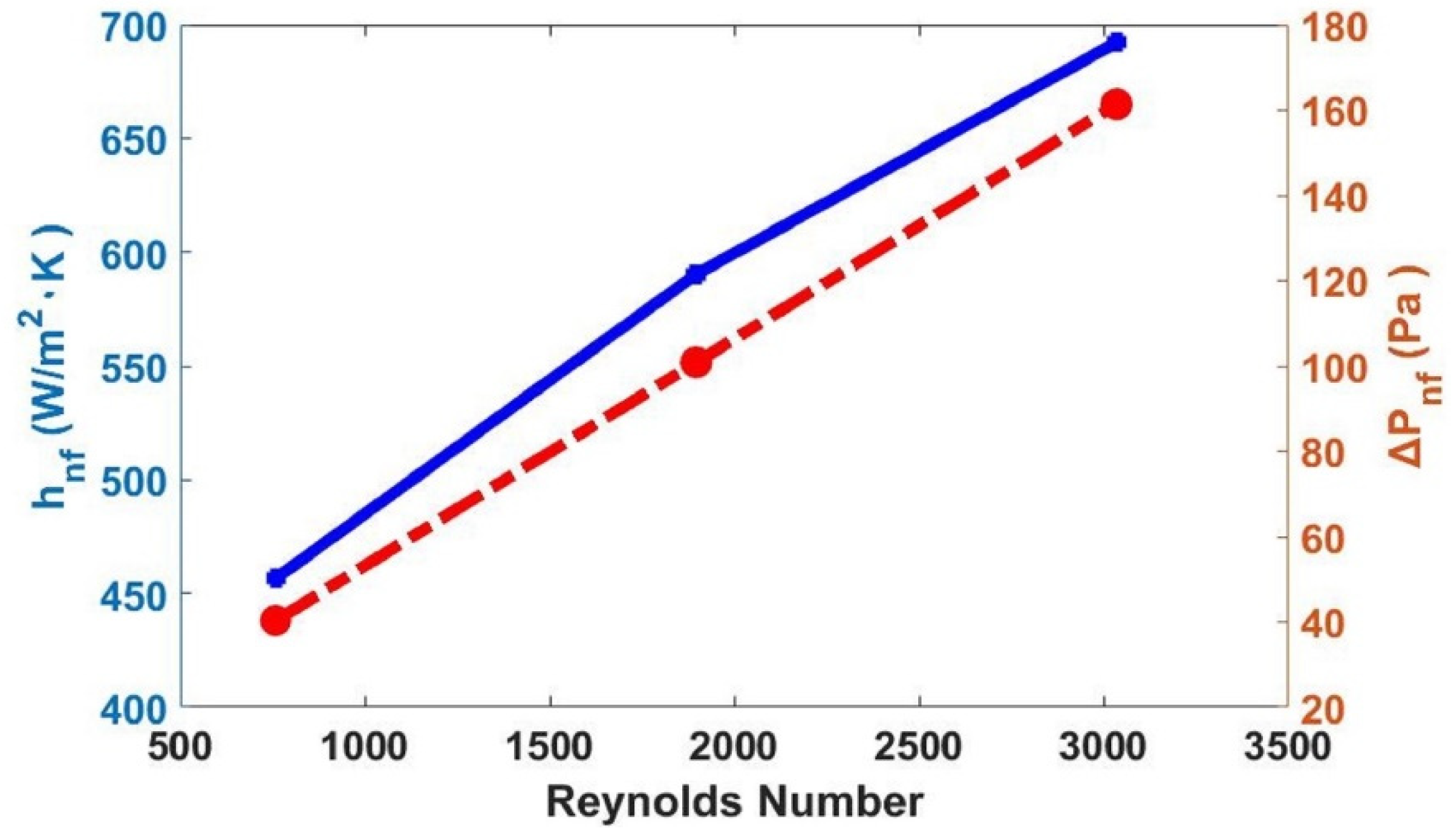
| Methods | Improvement Approach | Observations (by Percentage, %) | Ref. |
|---|---|---|---|
| Active | Using air bubble injection | The percentage improvement of the overall heat transfer coefficient can be from 10.30% to 149.50%. | [16] |
| Using surface vibrations | Heat transfer coefficient enhancement of 9% | [17] | |
| Using magnetic field | Heat transfer enhancement up to 320% and a slight increase in pressure drop | [18] | |
| Using ultrasonic vibration | Heat transfer is enhanced by about 60%. | [19] | |
| Passive | Porous media | Enhanced heat transfer of 44% with larger pressure drops | [20] |
| Using fins | Heat transfer rate enhancement of around 90–98%. Pressure drops for finned tube also increased. | [21] | |
| Helical wires | Augments Nusselt number by up to 2.64 fold. Increases friction factor by about 2.74 fold. | [22] | |
| Twisted tape | Significant (15%) enhancement in heat transfer rate. Friction factor increased by 10%. | [23] | |
| Metal foam | Nusselt number enhanced by 57.21%. | [24] | |
| Nanofluids (MgO-ethylene glycol) | Heat transfer coefficient enhancement of 27% for wt.% = 0.3 and 35% pressure drop at wt.% = 0.3. | [25] |
| Base Fluid | Nanoparticles | Particle Concentration (%) | Size (nm) | Temperature Range (°C) | Observation | Ref. |
|---|---|---|---|---|---|---|
| Ethylene glycol | MWCNT (multi-walled carbon nanotubes) | 0.02–0.10 | 12–30 | 30–60 | Thermal conductivity increased by 50% with a 0.06% concentration. Viscosity increased by 58% with a 0.1% concentration. | [51] |
| TH55 oil | Al2O3 | 0.10–1.00 | 40–50 | 20–90 | Thermal conductivity was enhanced by 8.44% at 65 °C with a 1.0% concentration. Density increased 3.31% at 20 °C with a 1.00% concentration. Viscosity at 30 °C improved by 28%. | [52] |
| TH55 oil | GNP (graphene nanoplatelets) | 0.01–0.10 | -- | 20–90 | Thermal conductivity was enhanced by 15.69% with a concentration of 0.10% at 65 °C. Density increased slightly compared to the base fluid. Viscosity at 30 °C improved by 32%. | [52] |
| 60% Ethylene glycol/40% water | CuO | 0.06 | <50 | <100 | Thermal conductivity improved by 26%, density improved by 29%, and viscosity improved by 27%. | [47] |
| Water | Al2O3 | 1.00 | 20 | 55 | Increased viscosity by 31% compared to the base fluid. | [45] |
| Water | MWCNT (multi-walled carbon nanotubes) | 0.30 | 15 | 25–70 | Thermal conductivity increased by 9.80–15.28%. Viscosity increased by 11.489.15%, and density increased as well. | [49] |
| Water | TiO2 | 0.25 | 8–18 | 30–60 | Average thermal conductivity increased by 8.5%, 6.0%, and 5.0%. Average density increased by 7%, 11%, and 24%. Average viscosity increased by 4.7%, 5.1%, and 5.3%, respectively. | [40] |
| ZnO | 12–28 | |||||
| Ag | 7–24 |
| Base Fluid | Nanoparticles | Particle Concentration (%) | Size (nm) | Temperature Range °C | Observation about Nanofluids Properties | Ref. |
|---|---|---|---|---|---|---|
| Water | Al2O3 | 1.0% | 20 | 10–50 | Thermal conductivity of 20 nm was enhanced by 1.54% and 2.43% more than those of 50 nm and 100 nm, respectively. No significant variation in density. | [53] |
| 50 | ||||||
| 100 | ||||||
| Water | SiO2 | -- | 15 | 25–65 | Thermal conductivity was improved by 3.80, 4.90, and 7.80%, respectively, compared to the base fluid. The viscosities increased by 6.10, 8.30, and 9.20% compared with those of pure water. | [54] |
| 30 | ||||||
| 80 | ||||||
| Ionic liquid | Al2O3 | 1.0% | 10 | 10–90 | Thermal conductivity was enhanced by 9.73%, 6.53%, 6.41%, and 7.60% for 10 nm, 30 nm, 60 nm, and 90 nm nanoparticles, respectively. Density and viscosity did not have significant differences based on the sizes of nanoparticles. | [55] |
| 30 | ||||||
| 60 | ||||||
| 90 | ||||||
| Water | CuO | 0.1% | 20 | 20–70 | Thermal conductivity of 25 nm (18%) was larger than the 50 nm size (15.60%) at 30 °C. | [30] |
| 50 | ||||||
| Engine oil | ZnO | 7.5% | 20 | -- | Viscosity increased with an increase in nanoparticle size by 3.80%, 4.61% 5.30%, 6.90%, and 9.23%, respectively. | [56] |
| 40 | ||||||
| 60 | ||||||
| 80 | ||||||
| 100 |
| Material | Inner Diameter (m) | Thickness (m) | Length (m) | |
|---|---|---|---|---|
| Inner tube | Copper | 0.007 | 0.00150 | 0.885 |
| Annular | Galvanized iron | 0.022 | 0.00275 | 0.885 |
| Concentration | 0% (Base Fluid) | 0.2% | 0.4% | 0.6% | 0.8% | Observation |
|---|---|---|---|---|---|---|
| knf (W/m. °C) | 0.6150 | 0.6180 | 0.6211 | 0.6241 | 0.6272 | Increased up to 1.98% |
| µnf (10−4 Pa. s) | 7.98 × 10−4 | 8.02 × 10−4 | 8.06 × 10−4 | 8.10 × 10−4 | 8.14 × 10−4 | Increased up to 2.03% |
| cpnf (J/kg. °C) | 4178 | 4148 | 4119 | 4090 | 4061 | Decreased up to 2.80% |
| ρnf (kg/m3) | 996 | 1002 | 1009 | 1015 | 1022 | Increased up to 2.61% |
| Flow rate (L/min) | 0.5 | 0.5 | 0.5 | 0.5 | 0.5 | One flow rate considered |
| Renf | 1891.10 | 1893.90 | 1896.70 | 1899.40 | 1901.90 | Laminar regime |
| hnf (W/m2. °C) | 586.66 | 588.43 | 590.28 | 592.12 | 594.04 | Increased up to 1.25% |
| ΔPnf (Pa) | 99.86 | 100.33 | 100.83 | 101.34 | 101.89 | Increased slightly up to 2.03% |
| Nanofluid Flow Variation in Double-Pipe Heat Exchanger (TiO2–Water) | Observation | |||
|---|---|---|---|---|
| Concentration | 0.4% | 0.4% | 0.4% | One percentage considered |
| Flow rate (L/min) | 0.2 | 0.5 | 0.8 | Variation |
| Renf | 758.68 | 1896.70 | 3034.70 | Increased by 59.90% |
| Nunf | 5.14 | 6.65 | 7.80 | Increased by 17.20% |
| hnf (W/m2. K) | 456.60 | 590.28 | 692.10 | Increasing up to 17.20% |
| ΔPnf (Pa) | 40.33 | 100.83 | 161.33 | Increasing up to 60% |
| Affecting Factors | Analysis | Nanofluid Thermophysical Property Remarks | Double-Tube Heat Exchanger Performance Remarks |
|---|---|---|---|
| Concentration of nanoparticles | Increment in volume fraction | Improved thermal conductivity, density, and viscosity. Decreased specific heat. | Enhanced heat transfer rate. Increased pressure drop. |
| Size of nanoparticles | Various sizes analyzed | Smaller ones enhanced thermal conductivity. Viscosity slightly increased. | Smaller ones provided better heat transfer and high efficiency. |
| Shape of nanoparticles | Blades, platelets, cylindrical, cubic, spherical | Cylindrical and bricks (cubic) enhanced thermal conductivity. Cylindrical and platelets enhanced viscosity. | Cylindrical and platelets present better heat transfer but increase pressure drop. Spherical shape presented lower percentage of pressure drop. |
| Flow regime of nanofluids | Increasing the flow | Classification of the regime flow: Laminar, transition, and turbulent | Heat transfer rate enhanced when Reynolds number increased. Obtained a high pressure drop. |
| Thermophysical properties of nanofluids (density, viscosity, and thermal conductivity) | Experimental and mathematical model | -- | Thermal conductivity enhanced heat transfer coefficient. Viscosity increased pressure drop. |
Publisher’s Note: MDPI stays neutral with regard to jurisdictional claims in published maps and institutional affiliations. |
© 2022 by the authors. Licensee MDPI, Basel, Switzerland. This article is an open access article distributed under the terms and conditions of the Creative Commons Attribution (CC BY) license (https://creativecommons.org/licenses/by/4.0/).
Share and Cite
Louis, S.P.; Ushak, S.; Milian, Y.; Nemś, M.; Nemś, A. Application of Nanofluids in Improving the Performance of Double-Pipe Heat Exchangers—A Critical Review. Materials 2022, 15, 6879. https://doi.org/10.3390/ma15196879
Louis SP, Ushak S, Milian Y, Nemś M, Nemś A. Application of Nanofluids in Improving the Performance of Double-Pipe Heat Exchangers—A Critical Review. Materials. 2022; 15(19):6879. https://doi.org/10.3390/ma15196879
Chicago/Turabian StyleLouis, Stephan Pierre, Svetlana Ushak, Yanio Milian, Magdalena Nemś, and Artur Nemś. 2022. "Application of Nanofluids in Improving the Performance of Double-Pipe Heat Exchangers—A Critical Review" Materials 15, no. 19: 6879. https://doi.org/10.3390/ma15196879





